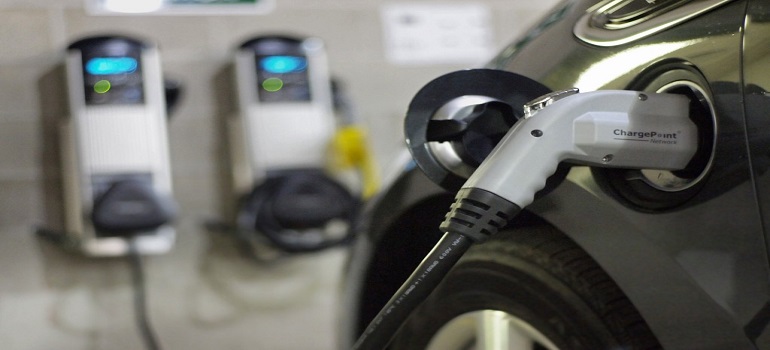
Electric vehicles powered by solar or wind are the key to developing a new, climate-friendly and sustainable model of mobility worldwide.
For e-mobility to catch on, there is one pressing need in particular: comprehensive charging infrastructure. Visitors to Power2Drive Europe will have the chance to explore how charging infrastructure is developing around the globe and what potential the market offers. The international exhibition for charging infrastructure and e-mobility will take place from June 20–22, 2018 at Messe München together with three other energy exhibitions under the umbrella of The smarter E Europe – making it the ideal meeting point for players within the energy and mobility industries.
Clean mobility solutions are on the rise. According to the German Federal Motor Transport Authority, 21,644 new electric vehicles and 26,560 plug-in hybrids were registered in Germany between January and November 2017 – representing growth of around 115 percent in each sector compared to the same period in the previous year. By 2030, up to 50 million electric cars will be on the roads worldwide, according to an estimate by the International Renewable Energy Agency (IRENA).
ALSO READ: BMTC looking for private players to run electric buses in the state: Report
To enhance the appeal of e-mobility, the industry is working on new e-car models and, in particular, on developing charging infrastructure. Integrating innovative charging technologies and concepts is also on the agenda. A comprehensive network of public charging stations is needed to solve the range problem and make longer journeys possible. Currently, 85 percent of the charging infrastructure in Germany is still privately owned – in homes, in parking lots and garages belonging to apartment complexes and multi-family dwellings, as well as in company parking lots.
ALSO READ: Tata Motors delivers first batch of Tigor Electric Vehicles to EESL
Investments in charging infrastructure are on the rise
In total there are currently 4,730 public charging stations in Germany, including 530 high-speed charging stations. They offer more than 10,700 public charging points. Businesses, utility companies and the public sector have recognized the importance of comprehensive infrastructure: This November, the joint venture IONITY, composed of leading automobile manufacturers, announced plans for a Europe-wide charging network. Around 400 high-speed charging stations are to be put in place along Europe’s major transport routes by 2020. On top of that, the German Federal Transport Ministry is adding high-speed charging stations and parking spaces for electric vehicles to the 400 rest stops along federal highways which are managed by the private company Autobahn Tank & Rast GmbH. And the European Commission has approved the 300 million euro incentive program set up by the Federal Ministry of Transport and Digital Infrastructure (BMVI). The aim is to develop a comprehensive charging infrastructure with 15,000 charging stations across Germany.
Charging infrastructure systems, concepts and technologies therefore offer enormous commercial potential. With more charging stations, new charging technologies and integration into existing power grids, e-mobility is enjoying a steady increase in interest and marketability. By 2025, the worldwide market for charging infrastructure could be worth around 46 billion dollars, according to an analysis by Grand View Research Inc.
Cross-sector cooperation leads to new business models
Energy distributors, automobile manufacturers and new players are jostling for space in this budding industry, bringing with them a range of innovative technologies and concepts. For example, the Power2Drive Europe exhibitor ubitricity is developing payment and billing solutions for power from charging stations. The Mobility House, also presenting at the exhibition, is building links to energy supply with vehicle-to-grid concepts and charging and energy storage solutions relating to vehicle batteries. And this year the energy company innogy will also be exhibiting. “We’ll be presenting our entire range of solutions at Power2Drive Europe – photovoltaic installations with battery storage systems, energy management and e-mobility,” says Elke Temme, Senior Vice President at innogy SE. “We’re preparing our customers for the new energy world.”
Close collaboration between mobility and climate-friendly energy supply offers a wealth of opportunities for the market; joint ventures such as IONITY are not confined to single industries. Efforts to move towards a new energy world are giving rise to growing numbers of cooperations that span multiple industries or sectors. Partnerships between charging solution providers, the energy industry and automobile manufacturers are becoming increasingly common. And as PV plant operators come together with providers of charging points or energy storage systems, new business models are developing with an eye to the efficient use of the clean power available.
Power2Drive Europe: The interface between the energy and mobility industries
Power2Drive Europe is a platform for the future which forms the decisive link between the energy and mobility industries. Innovative charging solutions, electric vehicle technologies and business models relating to e-mobility all feature in the diverse lineup of this new exhibition. The topic of charging infrastructure will dominate the spotlight. With exhibitors focusing on EV charging stations, connector systems, vehicle-to-grid, payment systems and more, Power2Drive Europe showcases every element of charging infrastructure. Together with the three other energy exhibitions Intersolar Europe, ees Europe and EM-Power, visitors will find that this event in Munich is the perfect place to gain a thorough overview of the energy and transport world of the future.
Power2Drive Europe and the parallel events will take place from June 20–22, 2018 under the umbrella of The smarter E Europe at Messe München.
Source: SOLAR PROMOTION GMBH

